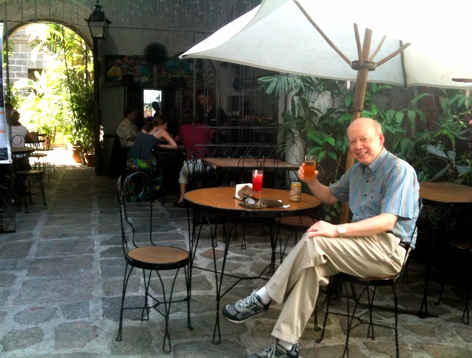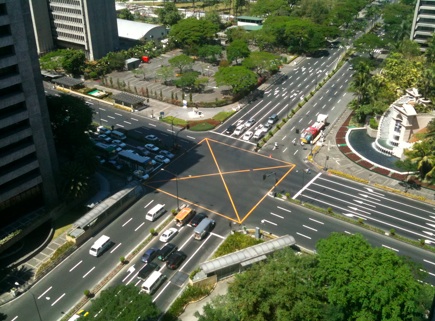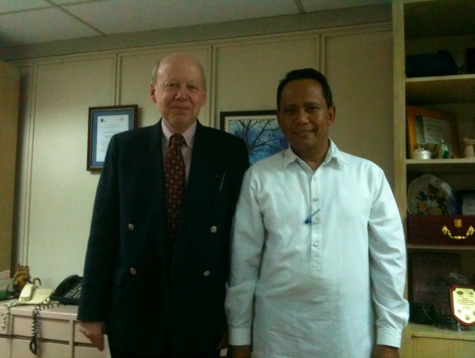
Investment in the Philippines: Time for a Second Look
  In March, 2010 I travelled to the Philippines with an investor to look at the possibilities for siting a factory there and for investment possibilities in the industrial, tourism and other sectors. It was my first visit back to the Philippines in at least 5 years and I must say I was impressed by what I saw and heard. The Philippines is aggressively moving forward to attract investment and has much to recommend itself including the wide usage of English language, a deep understanding and familiarity with western customs and work ethics, a workforce that contains large numbers of people who have worked overseas and for foreign companies and a government that seems to actively be seeking parity with other SE Asian nations in terms of investment promotion.   The author at the Intramuros We arrived on a Sunday at the old airport which according to many reports will probably be closed next year as airlines are transferred to the new airport which is much more spacious and up-to-date. For now Philippines Airlines and some of the smaller carriers have already moved but many of the international carriers are still in the older facility. We stayed at the Shangrila, Makati which is a good choice although Makati has a host of four and five star hotels which could also be considered. Makati is the main center of business in Manila although the former Fort Bonifacio area, now called “The Fort”, has been redeveloped with high rise commercial and residential areas and is also a favored area.
In 2009, the Philippines registered a net direct foreign investments in-flow of $1.95 billion, growing by 27% from $1.5 billion in 2008 according to the Bangko Sentral ng Pilipinas(BSP). According to BSP data, a total of $2.16 billion in foreign investment came into the country and $207 million left the country. The BSP Deputy Governor Diwa Guinigundo said “FDI had posted net inflow in the last two years despite the global crisis. This means market confidence in the Philippines, which was less affected by the crisis compared to other countries, was strong.” He further noted that the bulk of the foreign investment inflows last year went into business process outsourcing (BPO) ventures. Growth in GDP was about 3% last year and is expected to be 4-5% in 2010.   At the Board of Investment (BOI) On Monday, we went to the Board of Investments (BOI) of the Philippines which is part of the Department of Trade and Industry (DTI). The Philippines is officially known as the Republic of the Philippines. The country is nearly 300,000 sq. kms and had a population of 92.23 million according to the 2009 census. Manila has a population of roughly 10 million. According to the CIA Fact Book 2009 GDP per capitas using purchasing power parity was US $3,300. Literacy is high and the majority of the population speaks and understands english. The Philippines is actively promoting investment and has incentives focussed on income tax holidays, duty free importation of capital equipment and tax credits for inputs used in creating exports. These are comparable in most cases to other nations in the region. The Philippines recognizes the following business forms - single proprietorship, partnership, corporation, branch office, representative office, regional headquarters and regional operatingsingle proprietorship partnership corporation branch office representative office regional headquarters and regional operating headquarters.
Please note that the following are separate entities not under the BOI and act autonomously in authorizing and regulating investments in their zones of authority:
  Freeway
on the way to Clark Freeport Zone
Later in the week, we toured the Clark Development Authority (CDG) and Diosdado Macapagal International Airport which covers 2,367 hectares within the Clark Freeport Zone. This was the former Clark Air Force Base built by the U.S. and infrastructure throughout the zone is very good. A brand new expressway links Clark to the Subic Bay Metropolitan Authority (SBMA) which we also toured. Subic is one of the finest deep water ports anywhere in the world which is why the U.S. Navy located a base here. The base is long gone but the infrastructure throughout the zone owes much to this presence as does the protected forest and jungle surrounding the zone which is among the most pristine anywhere in the Philippines. Both Clark and Subic offer very interesting investment incentives and both are focussed on attracting international companies to locate in their zones. I would recommend any investor considering investing in the Philippines to consider these two locations.   At Clark Freeport Zone The next day we met with the Philippine Economic Zone Authority (PEZA). PEZA operates 207 economic zones focussed on export-oriented manufacture or services. Of these, 207 zones, four are run directly by PEZA and the remainder are operated by private firms under regulations and oversight provided by PEZA. Projects involve not only manufacture but also medical tourism, tourism, retirement, agriculture and agro business and IT. Companies locating in PEZA can be 100 % foreign owned. Forty percent of the factories located in PEZA are electronics factories and 9% are BPO investments. Fifty percent of PEZA investors are of Japanese nationality with the Philippines and the U.S. being the second and third largest group of investors by nationality.  Read more about Subic Bay in our article: Subic Bay Freeport Continues to Grow Five days in the Philippines is hardly enough to do this large nation of hundreds of islands justice. My assessment of the Philippines is that it is now gaining the momentum toward modernization that it lacked in the 90s. Makati and the Fort Bonifacio area are modern and possess all the necessary services. Filipinos are friendly, speak the best english anywhere in Asia and speak it more widely than any country in the immediate area. The Philippines can represent a good choice for some investors and certainly needs to be studied as companies plan their manufacturing and other needs for SE Asia. About the Author: Christopher W. Runckel, a former senior US diplomat who served in many counties in Asia, is a graduate of the University of Oregon and Lewis and Clark Law School. He served as Deputy General Counsel of President Gerald Ford’s Presidential Clemency Board. Mr. Runckel is the principal and founder of Runckel & Associates, a Portland, Oregon based consulting company that assists businesses expand business opportunities in Asia. (www.business-in-asia.com) Until April of 1999, Mr. Runckel was Minister-Counselor of the US Embassy in Beijing, China. Mr. Runckel lived and worked in Thailand for over six years. He was the first permanently assigned U.S. diplomat to return to Vietnam after the Vietnam War. In 1997, he was awarded the U.S. Department of States highest award for service, the Distinguished Honor Award, for his contribution to improving U.S.-Vietnam relations. Mr. Runckel is one of only two non-Ambassadors to receive this award in the 200-year history of the U.S. diplomatic service. |


